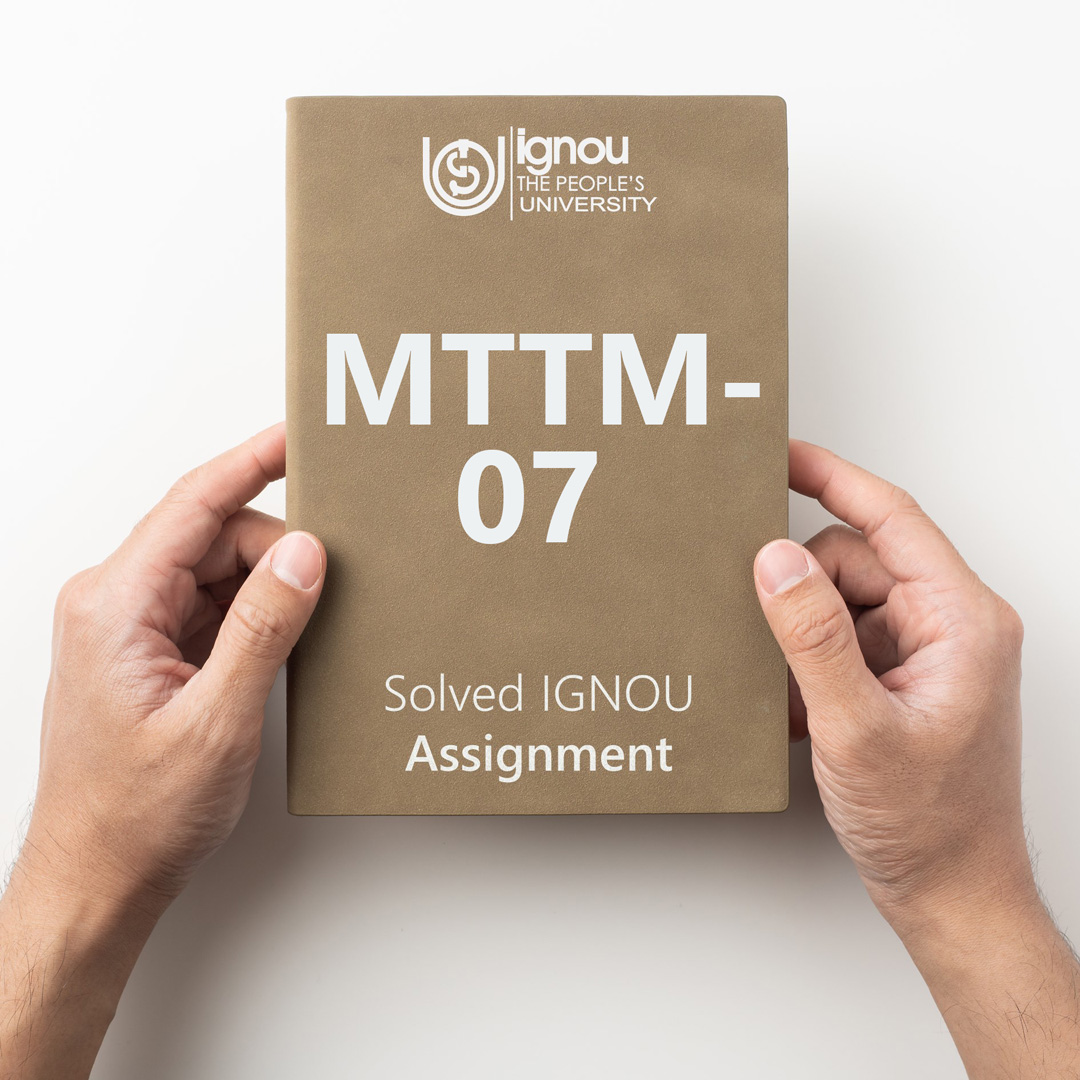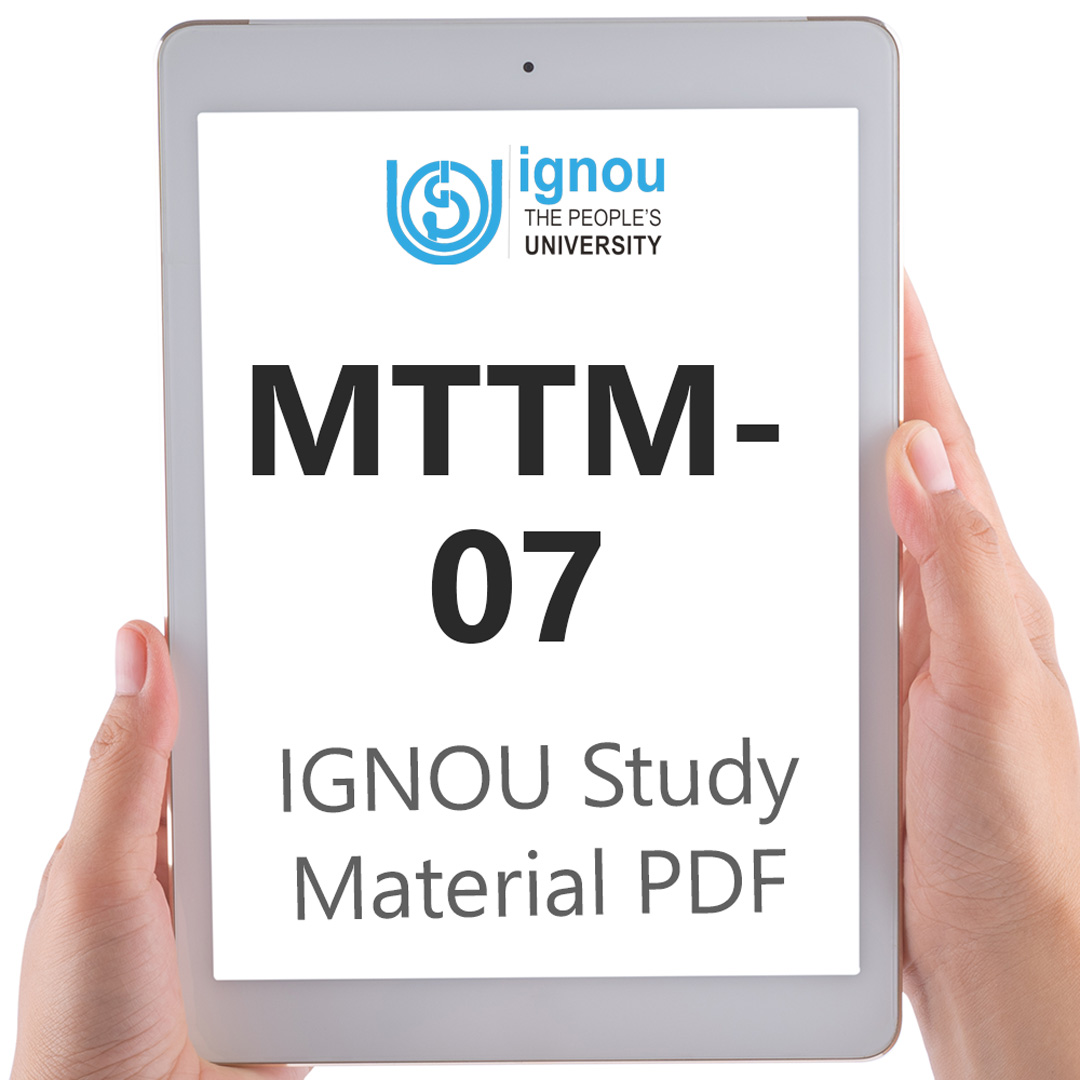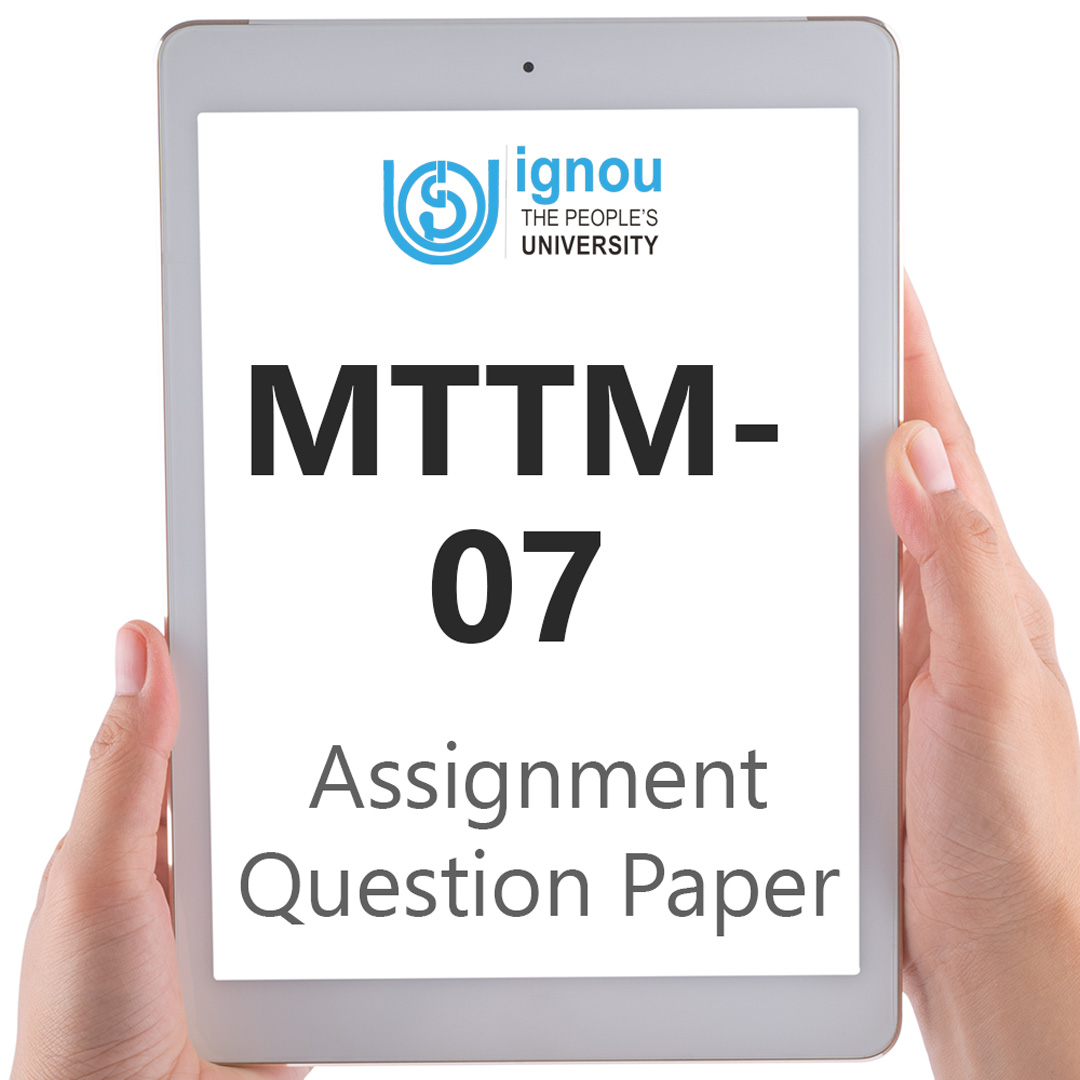If you are looking for MTTM-07 IGNOU Solved Assignment solution for the subject Managing Sales and Promotion in Tourism, you have come to the right place. MTTM-07 solution on this page applies to 2023 session students studying in MTTM courses of IGNOU.
MTTM-07 Solved Assignment Solution by Gyaniversity
Assignment Code: MTTM-7/MTM-7/TMA/2022
Course Code: MTTM 7/MTM-7
Assignment Name: Managing Sales and Promotion in Tourism
Year: 2022
Verification Status: Verified by Professor
1. Discuss Qualitative and Quantitative sales objectives. 20
Ans) The administration of the sales team and the activities that make up an organization's or company's sales effort is included in the sales management role, as was previously mentioned. To achieve corporate or organisational goals linked to market share, sales volume, and return on investment, sales managers are tasked with organising, planning, and executing the sales effort. The sales manager is required to engage in a variety of activities for this role, both inside and outside of the company.
The purpose of sales objectives is to put the existing sales resources to the best possible use. Additionally, they serve as benchmarks for actual performance comparison. Both quantitative and qualitative phrases are used to describe the sales objectives. The qualitative objectives typically have to do with enhancing connections with dealers, creating positive consumer support, eliminating product disinformation, achieving the desired corporate image, and so forth.
The senior management's expectations for the sales function's contribution to the overall marketing effort are reflected in the qualitative sales objectives. Therefore, they have an impact on both the quantity and calibre of the sales force. For instance, if a business selling expensive tour packages relies on its own sales staff to handle not only the entirety of the sales function but also a portion of the promotional responsibilities, the calibre and size of the sales staff the business will need will be very different from that of a business where sales staff is only needed to coordinate with the distribution channels.
To elaborate on this illustration, the service could be provided by an outward tour executive who sells European vacation packages to customers or by the GSA of an airline who works with travel brokers. In the first scenario, salespeople are expected to handle all aspects of selling and market development, whereas in the second scenario, they are primarily responsible for coordinating with service distributors. The company's marketing strategy forms the basis of the qualitative sales goals, which are comparatively long-term goals.
On the other hand, quantitative targets are related to the operating results that the company hopes to attain. They obviously change across operating periods and, like the qualitative objectives, rely primarily on careful study of the business' goals and the competitive environment.
In terms of sales volume, market share, or the amount of backorders every operational period, quantitative sales objectives could be set.
Goals can be established for the sales organisation based on these quantitative targets in terms of:
Number of sales units, reservations, or rupees.
Sales price.
Customer receivables
levels of supply or inventory.
Dealer assistance.
feedback information
It is important to note that the company's competitive position is taken into consideration while setting both the qualitative and quantitative sales objectives. As we begin the actual labour of developing a strategy, we assess different plans in light of the company's competitive advantages and disadvantages in the market, and we work to increase sales efforts in order to reach the desired objectives. We talk more about the crucial choices this task requires.
2. What is sales resistance? How the same is minimised? 20
Ans) This step in the selling process is crucial as well. It has to do with the objections a prospect raises during a sales call. Even after doing a good job of prospecting, preparing for each meeting, and giving a persuasive presentation, the prospects may still be unwilling to buy. Typically, this kind of resistance manifests itself as objections.
The prospects' real or false justifications for why they should not complete a sales call by making a purchase are known as objections. At their best, salespeople must handle objections diplomatically. Otherwise, it can negate all of the salesperson's efforts to get the business. The prospect's genuine objections are their genuine justifications for not purchasing the product. On the other hand, fictitious or false objections are examples of sincere objections.
Some instances of legitimate objections are, "I have no extra money right now to purchase your goods, even though I am certain of its utility." "I recently purchased a product that is similar." Sincere objections like, "What will you guarantee about the Product," "How quickly your service network replies," or "How much time your service employees generally take to attend complaint" can also be made by customers to get additional information about the product. For instance, "Why did you choose a green colour cough medicine when I would have bought it if it had been red," I don't think our floor can support its weight," are examples of disingenuous concerns.
Minimising Sales Resistance
Sales resistance is a fact of life for most people selling professional services. In any sales transaction we must negotiate 5 barriers. They can be real and permanent, which means no sale. Or they are merely perceptions the prospect currently entertains through lack of knowledge. How you address these perceptions can either lead to resistance or to satisfaction.
The key to eliminating sales resistance is to quickly identify whether these barriers are real and permanent or if they are only a temporary condition.
Selling is often made unnecessarily difficult by the method used by the salesperson, especially when they use a “push” selling model. The traditional “push” method of selling actually increases resistance because it often does not recognize these barriers in the sales transaction. With the push approach, salespeople waste much time and effort either trying to make a sale where these barriers are permanent or by using methods which increase resistance when the barriers are temporary.
There is a better way – The Pull (Attraction) Model.
With the pull or attraction model, there is very little need to “sell,” as selling is normally understood. In the attraction approach, the focus is on the customer rather than what you are selling. This approach recognizes that no one is interested in your solution until they have identified a need. The main focus of your marketing should be to first highlight and identify needs, rather than inform about solutions or services you might offer. Most of the sales conversation is about the customer and their circumstances. Your job as a sales person is to identify a need, before you present your solution. You also view the customer as a long term client of your business, rather than a sales prospect who may buy today and never come back.
There are a number of clear steps in the attraction model which eliminate much of the resistance that the push approach suffers. The model looks like this:
Identify a specific target market (your premium clients)
Educate prospects with a specific need
Build credibility and trust
Fact finding diagnosis
Recommendation and clarification
Open ongoing relationship.
3. What do you know about principles of presentation? Explain. 20
Ans) Based on his presentations to customers, Ron Hoff, the head of Ron Hoff and Associates and a hard-core advertising expert, has recommended some fundamental rules for a successful presentation. Let's talk about these eight practical presentation ideas that can actually affect how well your presentation goes.
Rule Description
Maybe we should start working on our presentation about halfway through.
The primary requirement of any presentation is always content. Delivery always follows when substance falters.
You can never be too explicit.
Remember that just around 25% of what you say will be retained by your listeners.
The audience will remember you and your message if they participate, but "handle with caution." Being involved may backfire.
Although being anxious is not always a bad thing, it can become problematic if your audience is more interested in your anxiety than your subject.
The most powerful thing working in your favour during a "Live" Presentation is eye contact.
Even though people can lie, body language never does.
Start Half Way
We should begin working on our presentation about halfway through. Every audience has thought to itself at some point or another. When will the speaker start discussing my business instead than his own? Why not start my plan with "a problem of direct significance to my audience" instead of "Opening Remarks"? Our chances of getting a favourable verdict are best if we can stop being self-conscious and start being audience-conscious as soon as possible.
Plan Out Content
The primary requirement of any presentation is always content. Delivery always follows when substance falters. Our voice will get more tense if we don't know your subject well. Our actions will be hesitant if we don't really mean what you are saying. Our body language will speak for us if we are caught off guard by a question.
Partial Receptivity
Remember that just around 25% of what we say will be retained by our listeners. Unexpectedly many speakers will think that after they make a point, the audience will remember it. In fact, if spoken content is supported by visuals, the average audience retains about 25% of a lecture.
Encourage Participation
The audience's engagement will help them remember you and your message, but "manage with care" because it might also backfire. We can ask your audience to do practically anything as the presenter. Surprisingly, most audiences are amenable.
Control Nervousness
Although being anxious is not always a bad thing, it can become problematic if your audience is more interested in your anxiety than our subject. There are strategies for dealing with it, and some of them may even be effective.
Any form of exercise relieves the stress that leads to anxiety.
The nervous system is always calmed by deep breathing.
Remind yourself that the sole purpose of your presentation is to actually assist the audience.
Eye Contact
The most powerful thing working in our favour during a "Live" Presentation is eye contact. If we can see our audience during your next presentation, we will be able to tell if we are making eye contact or not.
Body Language
Even though people can lie, body language never does. Once we learn to understand body language, it will be more telling than what our audience will say.
4. Describe types of display. How displays will be managed effectively? 20
Ans) A number of the display kinds categorised below:
Assortment Display : A store presents a wide range of goods for the buyer in this style of display. There are two layouts for this display: open and closed. Customers get the chance to touch or use the products when there are open displays.
The products are kept enclosed in glass windows or in pre-packaged form in closed displays, however. Retail establishments with counter service and those that offer pricey (like jewellery) or delicate goods frequently employ closed displays.
Theme Displays: These displays operate under the tenet of uniting the items on show around a common topic or event, and as a result, they necessitate the establishment of a suitable mood or ambiance in the business. These exhibits are designed to increase client experience by immersing them more fully in the goods and the event.
Life-Style Displays: Retail stores utilise lifestyle displays based on the activities, interests, and attitudes of a particular client category. This is known as the market segmentation strategy. The goal is to provide the target customer a cosy impression of the retail space and the sense that they are in the correct place to purchase.
Coordinated or Ensemble Displays: In this style of display, a mannequin is typically dressed in matching items such as a pair of shoes, socks, pants or shorts, a shirt or T-shirt, a sports jacket, and even a tennis racket and bags.
Managing Displays Effectively
Effective organisation and management of sales displays are required to maximise their benefits.
There are two phases to the display management process:
Planning of Sales Displays: The planning stage for sales displays includes aspects like:
Maximum use of the display area.
Usage of affordable display setups that provide the product the most visibility possible
The style and pattern of the display to be used, as well as how well they fit with the store's layout and available space.
The price and frequency of display changes in the retail space.
Execution of Sales Displays: Included in this stage of display management are:
Guaranteeing an adequate supply of goods in both inventories and displays.
Establishing a designated space for the placement of various displays and equipment.
Inspecting the display fixtures that were purchased for usage in exhibits for both quality and features.
Taking care of display-related details including the store name board, store front, display window size, the design and colour of display signs to be used, as well as the lighting and atmospherics of the display window, which may include the floors, walls, ceilings, ventilation, cooling, and heating.
Coordinating with other store employees and selecting outside specialists, if any, as well as organising the people and supplies for the exhibit.
Educating store employees on how to handle displays and goods.
Coordinating the store's timely PR and advertising.
The following criteria are listed by Ovid Riso in his edited "Sales Promotion Handbook" as necessary for an effective product display:
It must be simple to assemble and strong enough to hold up properly. It shouldn't need to be fastened, tacked, or attached to any other fixture and should have its own easel or base.
If there is even the tiniest chance that the customer cannot immediately see exactly how to use it, it should show the product in use.
It need to be bright, attractive, and uncomplicated.
It ought to contain information, including the cost.
5. What are the abilities possess by trainers to do a good job of training? 20
Ans) A training need is a gap that can be filled by training between the intended and actual levels of knowledge, abilities, or performance. The rigorous and accurate analysis of training needs is the first step in planning and carrying out an efficient training programme for salespeople.
Although well-intentioned, broad sales training may not be successful. It might not seem suited to the salesperson's requirements or fail to consider the unique selling circumstances they frequently encounter.
A trainer needs to have a range of skills to train people effectively. To be successful, a trainer must possess a thorough knowledge of their subject and the capacity to relate to the problems that salespeople confront in the real world.
The other crucial abilities a trainer needs to have are:
Analytical Ability
An effective trainer is able to assess the circumstances and pinpoint the precise salesperson training requirements. The trainer will be better able to concentrate on important issues rather than trivial ones with the aid of their analytical skills.
Basic Educational Abilities
A trainer must be knowledgeable with the tasks carried out by salespeople. Additionally, he or she ought to be familiar with communication norms. Even so, it would be preferable if the trainer had some experience with adult education.
Training Techniques
A competent trainer must comprehend the factors that influence learning and openness to change. He or she should be well-versed in the various training methods. For best success, he or she should be able to use these strategies.
Ensuring Participants’ Participation
The training session must be interactive with open participation for learning to take place effectively. A few strategies used to guarantee learner participation are:
Discussion Groups: Groups of trainees are split up and given various subjects, problems, etc. to discuss and come up with potential solutions for.
Following each session is a questions and answers period.
Exercises in decision-making, such as identifying product benefits and turning them into sales presentations for various types of clients.
Demonstrations: These might be video demonstrations or live trainer demonstrations, or they could be trainees playing out specific role plays.
Case Studies: a collaborative effort to identify the ideal answer to a practical issue.
Course Organisation
Once all of the written course content has been finished, the session can be used. A knowledgeable trainer will always keep in mind a few key rules for organising a training session, such as:
It's important to be on time.
All training-related materials, including presentations, demonstration items, samples, etc., must be carefully inspected prior to the programme.
It is important to ensure that the training space has sufficient lighting and chairs.
The "training follow-up" is the time immediately following the training. This might occur while the students are still acting as captive audiences or months or years after the lesson. A post-training phase is necessary for every training session. After any training session, you must compile and analyse feedback in order to review the training. Results need to be measured and evaluated, especially in light of work output. If there was a material shortage, additional should have been provided so that subsequent training sessions could use the same materials.






